|
|
|
|

|
|
|
|
FRIDAY AFTERNOON |
|
After equalizing the batteries we moved them back to their original location. We changed their relative position in the rows. |
|
|
|
|
|
|
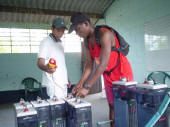
|
|
|
|
FRIDAY AFTERNOON |
|
Walter and JosÚ are measuring the voltage of each one of the batteries. In average, the voltage of the batteries was 2.1 V |
|
|
|
|
|
|
|
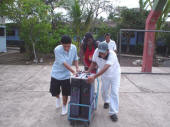
|
|
|
|
FRIDAY AFTERNOON |
|
Federico, Jose and Walter are moving 4 batteries from the room where they were charged and cleaned to the control room. |
|
|
|
|
|
|

|
|
|
|
SATURDAY AFTERNOON |
|
Twenty-four new nuts (to the right) were custom made at a local metal shop using bronze. |
|
|
|
|
|
|
|
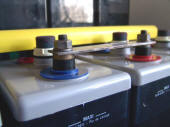
|
|
|
|
SATURDAY AFTERNOON |
|
The newly charged and cleaned batteries were re-connected in series for the 48V system. |
|
|
|
|
|
|

|
|
|
|
SATURDAY AFTERNOON |
|
The new PV equipment and DAQ system is wired. The inverters are grid-tied. |
|
|
|
|
|
|
|
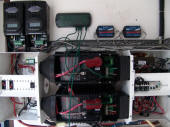
|
|
|
|
SATURDAY AFTERNOON |
|
2 Outback FX2548 inverters: 48V - 2.5 KW each
2 Outback charge controllers MX60: 60 A -120 Vdc
1 DC breaker box and 1 AC breaker box with an autotransformer. |
|
|
|
|
|
|
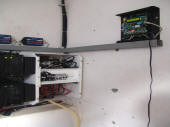
|
|
|
|
SATURDAY AFTERNOON |
|
The DAQ system has 2 KWh meters: one for AC consumption and 1 for AC demand. The DAQ also includes one DC voltage sensor to measure the system voltage and 1 DC current sensor to measure the PV current. |
|
|
|
|
|
|
|
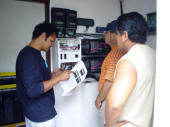
|
|
|
|
MONDAY AFTERNOON |
|
I'm checking the connections with Enrique and Luis once again before turning the system on for the first time. Today we configured the inverters and charge controllers. |
|
|
|
|
|
|
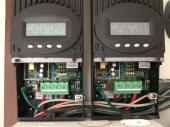
|
|
|
|
MONDAY AFTERNOON |
|
Each charge controller has a maximum current input of 60 Adc but the manufacturer recommends 48A. They only share a common output. Each one only ties with Array A or B at the input. |
|
|
|
|
|
|
|
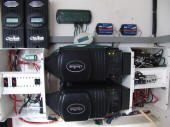
|
|
|
|
MONDAY AFTERNOON |
|
The inverter on top acts as the Master unit and the one at the bottom as the Slave unit. On top of the Master inverter is the control unit that connects to the charge controllers and the inverters through the communications hub (long green device attached to the wall) |
|
|
|
|
|
|
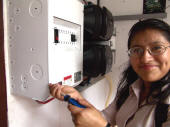
|
|
|
|
MONDAY AFTERNOON |
|
Alexandra is attaching the cover to the DC breaker box. She put the last bolt for the system. The DC box has breakers to disconnect the PV array from the system, the batteries from the system and the inverters from the DC supply. |
|
|
|
|
|
|
|
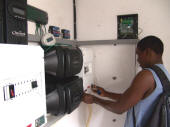
|
|
|
|
MONDAY AFTERNOON |
|
JosÚ is checking the AC breaker box cover. This box has breakers for the public-grid supply, for the computer lab and a bypass switch to cut-off the PV system while still supplying power to the load. |
|
|
|
|
|
|
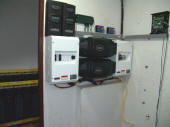
|
|
|
|
MONDAY EVENING |
|
The system is in operation!!
The inverters will consume energy from the public grid only in the case that the batteries are not able to provide the demand for the load (computer lab) |
|
|
|
|
|
|
|
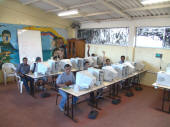
|
|
|
|
TUESDAY MORNING |
|
Part of the solar team at the computer lab. The PV system provides energy fro 8 computers, one server, one printer, one scanner (all with UPS) and all the lamps in the room. The total estimated load is: 1.4 KW |
|
|
|
|
|
|
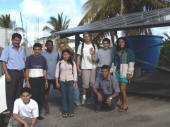
|
|
|
|
TUESDAY MORNING |
|
Some of the participants in the workshop:
Federico (seated) Luis, Ricardo, Jose, Alexandra, Raimundo, Federico, Wilson, Patricia and Bolivar (seated) |
|
|
|
|
|
|
|

|
|
|
|
TUESDAY MORNING |
|
I believe that all the participants feel closer to the PV system in their hands through the direct involvement in its reconstruction. |
|
|
|
|
|
|
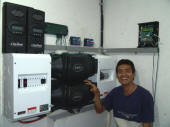
|
|
|
|
TUESDAY AFTERNOON |
|
Ricardo is confident that the new system will last for many years and that it will be an educational tool as well as a motivation to use renewable energy sources. |
|
|
|
|
|
|
|
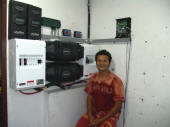
|
|
|
|
TUESDAY AFTERNOON |
|
I was very happy to manage this project and have a hands-on experience in it. I felt very welcome by the teachers, students and staff. I was able to motivate people to participate in the project and to successfully complete it. |
|
|
|
|
|
|
